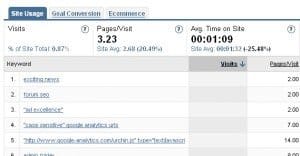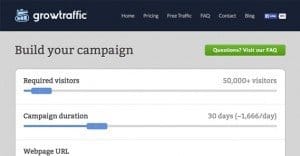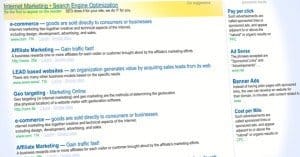The Ultimate Guide to Doubling Your Website Traffic

How much traffic do you have right now? A few hundred visitors each month? A few thousand? A hundred thousand? How much would your business change if your traffic doubled? If you want, you can make your traffic double, in as little as a month of solid work.
Step 1: Keyword Research
If you don’t already have great keyword research under your belt, you need to do it now. If you do, it might be worth taking this opportunity to do some more, just to see if the landscape has changed.
Avoid two situations.
- Situation 1: Your keyword choices are lucrative, but high competition, with your competitors operating from more established positions with larger budgets.
- Situation 2: Your keyword choices are lucrative and low competition, but also very low volume, such that you cannot support a growing business model.
Most people have the urge to go for the generic, blanket keywords that have high volume but aren’t necessarily super relevant to your site. “Flights to Europe” might be a high volume, lucrative keyword that fits your business, but if you only sell cheap flights to Germany, you can find more precise keywords. Target people looking for “cheap flights to Germany” and you’ll have a much better time. Don’t get too specific, though; “Flights to Munich under $100” is unlikely to give you any real returns.
Use Google – not the keyword planner, not webmaster tools, just the search engine – and plug in your prospective keywords. Take a look at the ads that show up. They’ll appear in both the top bar and sidebar. What do you see?
- Nothing. No ads. This means either you’ve found the holy grail of a high volume, lucrative keyword with no competition… or, more likely, there’s not enough volume to support a site, so no one uses the keyword.
- A few ads, most as basic as they come. This may be an area ripe for the picking.
- Multiple ads, many with rich snippets. This can indicate a good niche, or it can indicate competition you can’t out-bid. Only digging deeper will tell you which is true.
Once you’ve identified a few good candidates, use AdWords and set up a basic campaign with exact match targeting. You’re going to want to point the ad to some relevant page on your site – don’t worry about a custom landing page just yet – and accumulate a few hundred clicks for testing purposes. Measure how long it took to gain those clicks, how many impressions you got for each click, how many conversions you pulled in, and so forth.
Step 2: Establish or Boost a Content Schedule
You’re going to want a constant stream of content, possibly more than you currently publish, depending on what your current schedule looks like. Shoot for a minimum of three posts per week. If you can support it, one post per day, seven days per week is very effective. You don’t need to go into multiple posts per day unless you’re in a very fast field where trending information is paramount, like the tech or financial sectors.
To assist with this, you have a few options. First and foremost, you need some kind of editorial calendar. This plugin is a good one, though you can use any of a dozen services for the same effect. The goal is to be able to schedule your posts in advance, so you don’t hit a deadline and scramble to write something.
To create posts, you also have a few options.
- Write them yourself as inspiration comes, and schedule them into the future as necessary to keep your schedule up.
- Hire a freelancer to ghostwrite posts for you.
- Purchase bulk content from a freelancer or content mill.
- Hire staff writers to write for your business under their own names.
- Accumulate guest posts from industry authorities to fill in holes.
As for coming up with topics, the sky is the limit. Write about anything related to your business and your industry. Write evergreen guides. Write on trending topics. Write about infographics. Take lists other blogs have written and write better versions. If you ever have writer’s block, do some Google searches for keywords and see what’s trending.
The posts themselves should be around 1,000 words in length, though you can go as low as 800 and still hold value. Anything above 2,000 might be worth splitting up into separate posts or expanding further into an ebook. When in doubt, run a little long.
Step 3: A Giveaway
A giveaway is a great way to get a whole swath of new users, but you have to make it a good one. You can’t just buy an iPad to give away and assume it’s going to attract the right kind of users. You’ll bring in a lot of people, yes; people from slickdeals and reddit coming from threads titled “X Business Giving Away Free iPad” who will never come back once they lose.
Send out a quick, personalized email to everyone on your list and ask what their most pressing problem related to your topic happens to be. Go through the answers you receive and figure out what the biggest, most pressing problem is. Create something that solves that problem, or assists them in solving it themselves, like an ebook or a training course. Now give that away in exchange for something simple, like a referral, opt-in or share.
Step 4: Social Media
Chances are you have some social presence, but it might not be doing you any good. What you need to do here depends on your current social presence. Either establish a presence on the biggest three sites for your industry – typically Facebook, Twitter and a nebulous third choice – or dial back to those three. If you have an ongoing solid presence, you can take this opportunity to kick it up a notch.
The rules for profiting from social media are generally simple:
- Post often.
- Post casually.
- Avoid advertising.
- Use multimedia.
- Curate content in addition to posting your own content.
- Post at the right times of day.
- Post in a way that encourages engagement.
At this point, you have a good blog on a good site, you have a social presence and you have solid research backing it all up. You can leverage all of this into paid advertising, guest posting and other opportunities. Some ideas might include blog commenting, Facebook ads, AdSense utilization and even using sites like Reddit for added benefit. You can even look up what experts have done and mimic their techniques.
 ContentPowered.com
ContentPowered.com





How long does this normally take to happen? I’d love to double my traffic and I’ve been trying for a while but I’m not sure what I’m getting myself into. Any help at all is appreciated!